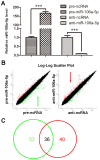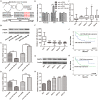miR-106a-5p inhibits the proliferation and migration of astrocytoma cells and promotes apoptosis by targeting FASTK
- PMID: 24013584
- PMCID: PMC3754986
- DOI: 10.1371/journal.pone.0072390
miR-106a-5p inhibits the proliferation and migration of astrocytoma cells and promotes apoptosis by targeting FASTK
Abstract
Astrocytomas are common malignant intracranial tumors that comprise the majority of adult primary central nervous system tumors. MicroRNAs (miRNAs) are small, non-coding RNAs (20-24 nucleotides) that post-transcriptionally modulate gene expression by negatively regulating the stability or translational efficiency of their target mRNAs. In our previous studies, we found that the downregulation of miR-106a-5p in astrocytomas is associated with poor prognosis. However, its specific gene target(s) and underlying functional mechanism(s) in astrocytomas remain unclear. In this study, we used mRNA microarray experiments to measure global mRNA expression in the presence of increased or decreased miR-106a-5p levels. We then performed bioinformatics analysis based on multiple target prediction algorithms to obtain candidate target genes that were further validated by computational predictions, western blot analysis, quantitative real-time PCR, and the luciferase reporter assay. Fas-activated serine/threonine kinase (FASTK) was identified as a direct target of miR-106a-5p. In human astrocytomas, miR-106a-5p is downregulated and negatively associated with clinical staging, whereas FASTK is upregulated and positively associated with advanced clinical stages, at both the protein and mRNA levels. Furthermore, Kaplan-Meier analysis revealed that the reduced expression of miR-106a-5p or the increased expression of FASTK is significantly associated with poor survival outcome. These results further supported the finding that FASTK is a direct target gene of miR-106a-5p. Next, we explored the function of miR-106a-5p and FASTK during astrocytoma progression. Through gain-of-function and loss-of-function studies, we demonstrated that miR-106a-5p can significantly inhibit cell proliferation and migration and can promote cell apoptosis in vitro. The knockdown of FASTK induced similar effects on astrocytoma cells as those induced by the overexpression of miR-106a-5p. These observations suggest that miR-106a-5p functions as a tumor suppressor during the development of astrocytomas by targeting FASTK.
Conflict of interest statement
Figures



References
-
- Wen PY, Kesari S (2008) Malignant gliomas in adults. N Engl J Med 359: 492–507. - PubMed
-
- Gabayan AJ, Green SB, Sanan A, Jenrette J, Schultz C, et al... (2006) GliaSite brachytherapy for treatment of recurrent malignant gliomas: a retrospective multi-institutional analysis. Neurosurgery 58: 701–709; discussion 701–709. - PubMed
-
- Endersby R, Baker SJ (2008) PTEN signaling in brain: neuropathology and tumorigenesis. Oncogene 27: 5416–5430. - PubMed
-
- Bartel DP (2004) MicroRNAs: genomics, biogenesis, mechanism, and function. Cell 116: 281–297. - PubMed
Publication types
MeSH terms
Substances
LinkOut - more resources
Full Text Sources
Other Literature Sources
Medical
Molecular Biology Databases
Research Materials
Miscellaneous

